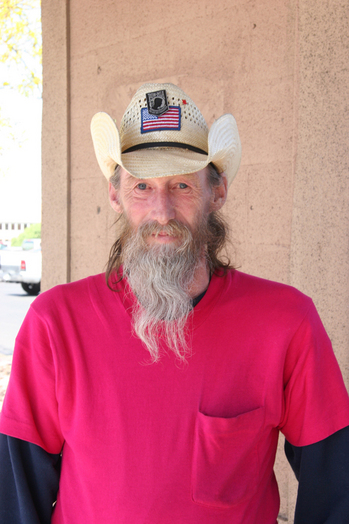Art & Ideas exhibit displays the faces of 'Social Realism 2010'

“Male 1 (Albuquerque)” by Shaqe Kalaj.
Social Realism—not to be confused with the Soviet Union’s propaganda art form, “socialist realism”—makes an exceedingly clever return in Plymouth Township’s Art and Ideas Gallery “Social Realism 2010.”
This movement’s photographic element (as exemplified by the works of Berenice Abbott, Margaret Bourke-White, Walker Evans, Dorothea Lange, Gordon Parks, and Edward Steichen) was primarily a strain of American regionalism whose antecedents included the 19th century French realists and the early 20th century New York City Ash Can School.
These photographers were interested in social injustice as revealed through artless slices of life during the Great Depression. As such, social realism was a photojournalistic aesthetic that sought to arouse both emotion and social consciousness through its championing of the underrepresented and economically downtrodden. Art and Ideas “Social Realism 2010” works on a slightly different tangent—even if the topic remains roughly the same.
The exhibit features the work of three accomplished southeastern/central Michigan photographers: Thomas McMillen-Oakley of Jackson, Julia DeClerck of Metamora, and Shaqe Kalaj of Livonia — Art and Ideas’ current artist-in-residence and curator of the display — who says she wanted photographers for the show whose work communicates the “social truths” those earlier photographers sought.
“But in our case,” says Kalaj in her gallery statement, “we were also looking for humor and irony depicted about our current situation in the USA and Southeast Michigan.”
This makes the exhibit compelling, because there’s certainly more than enough social and economic strife to be found in today’s America —Â even if conditions are far different from the late 1920s-1930s. As the gallery’s exhibition statement makes clear, this trio of photographers crafts “contemporary takes on ‘reality’ (that) incorporate irony, wit, and ambiguity.”
Tthis social commonality — rather than the squalid desperation to be found in the 20th century’s social realism — that gives the exhibit its more subtle, wry undercurrent.
Thomas McMillen-Oakley is the more formally aesthetically adventurous of this trio. His work uses pinhole cameras and differing processing techniques to augment his “Dangerous Lives of Children” photographic series.
Whether working in pinhole black and white or processed color, McMillen-Oakley constructs slices of Americana that are contextually ambiguous. His 21 subjects run from working-class to middle class with an emphasis on youth that makes the work that much more poignant.
A contrast between the pinhole “Colton dropping by” and color “Carson G: Monster killer” illustrates the photographic strength this Jackson Community College studio art professor brings to “Social Realism 2010.” “Colton dropping by” is a black and white pinhole marvel that captures a young boy being tossed in the air by his father. The youth, with his arms slightly outstretched for balance, is caught perfectly prone in midflight—and the photo is all the more remarkable given the low-tech nature of pinhole photography’s variable exposure. By contrast, “Carson G: Monster killer” is a far-reaching delight. The green and red photograph features the double-image of a young boy holding a toy gun at the viewer with indistinct “rubber ghouls” placed in the lens foreground. It’s a fascinating juxtaposition.
Julia DeClerck’s 15 black and white and color “Real Pretend” photographs in this exhibit are an off-the-cuff photo verite that’s easily as much photojournalism as it is accomplished art photography. “The anger, rage, and mimicked self-destructive acts captured through my lens,” she says in her gallery statement, “can no longer be seen as comical or overreaching (pretend); the way adults tend to dismiss children’s behavior.”
As seen through her color “Hold It In” photograph and the black and white “Excavation,” DeClerck’s work is certainly no feint. #8220;Hold It In” is an extemporaneous composition of a distressed young girl holding her right hand to her face as she clutches her chest with her left hand. And “Excavation” fully fits the exhibit’s definition with its ambiguous spontaneity of a young child scooping dirt on a litter-strewn ground.
Ultimately, Shaqe Kalaj’s color “Cityology” portraiture series is the exhibit’s purest example of 2010 social realism. Unvarnished life come to fore in these disarming portraits that are as much straightforward psychological studies as they are penetrating works of art.
Kalaj’s subjects are photographed looking deadpan at her camera with little gesticulation or animation. Rather, her camera peers beyond her subject’s appearance for the minutiae that marks them as individuals because the socio-economic particulars are certainly there.
“Male 1 (Albuquerque)” shows us everything to fbe ound in Kalaj’s work. Unpretentious and disarmed, her scraggy model looks straight into her camera as a heartfelt signifier of 21st century social reality. Neither proud, nor apologetic, he simply is—and this is more than enough. Kalaj shows us that in many fundamental respects, little has seemingly changed in nearly a century.
“Social Realism 2010: Photographs by Thomas McMillen-Oakley, Shaqe Kalaj; Julia DeClerck” will continue through Sept. 18 at Art & Ideas, 15095 Northville Rd., Plymouth Township. Exhibit hours are 5 to 7 p.m., Tuesday-Thursday; and 1 to 8 p.m. Friday and Saturday. For information, call 734-420-0775.

